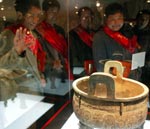 When five farmers stumbled on a hidden cache of rusty bronze objects in a field they were digging, they had little idea of the significance of what they'd just unearthed.
When five farmers stumbled on a hidden cache of rusty bronze objects in a field they were digging, they had little idea of the significance of what they'd just unearthed.
Like many of China's previous archaeological discoveries, the Yangjia Village find in Shaanxi Province was made totally by chance.
The chain of events which followed lead to the unveiling of the find to the public in Beijing at the weekend as part of an ongoing exhibition which casts more light on the country's hitherto unrecorded history.
The bronze ware has been dated to the later period of the Western Zhou Dynasty (c. 11th century-771 BC)and has immediately sparked the excited enthusiasm of archaeologists wanting to breathe new life into the study of dynastic history.
The 27 items are on show at an exhibition whose name translates into English as The 21st Century Great Archaeology Discovery in Baoji. It was launched on Sunday at China Millennium Monument.
"The discovery is very, very important and can be said to be the most important in 10 years. It is no exaggeration to use the word 'shock' to express my feeling and it will surely cause a great stir at home and abroad," said Li Xueqin.
He's a chief researcher into the Dynastic History of the Xia Dynasty (c. 21st century-16th century BC), the Shang Dynasty (c. 16th century-11th century BC) and the Zhou Dynasty (c.11th century-256 BC).
Like many other major archaeological discoveries, the buried treasure was also found by chance.
On January 19, five local farmers of Yangjia Village - Wang Ningxian, Wang Laqian, Wang Mingsuo, Wang Qinning and Zhang Qinhui - were loading earth on a tractor outside the village.
At about four o'clock, Wang Laqian spotted a coffin-like object in the hole he was digging. Wang Ningxian and Wang Mingsuo peeped through. They realized they'd possibly found something important.
"We all agreed to report it to the government so we covered the hole with a clod and went back to make the phone call," recounted 51-year-old Wang Ningxian, the oldest of the five.
By 6 pm, representatives of the county's Cultural Relics Bureau and Cultural Palace arrived to carry out initial investigations.
The director of the cultural relics group of the Cultural Palace, Liu Huaijun, was one of the first on the spot.
"My instinct told me that this time must be different," explained Liu, an archaeology graduate who has worked in the field for 20 years. With feelings of fear and excitement, he reported back to the County Cultural Bureau.
"Frankly speaking, I was rather anxious then by the fear of plundering of the relics by people at the spot," he admitted.
"We pretended to be uninterested to dilute the curiosity of surrounding people."
Liu's true feelings were proved well founded. The "rescue" operation started at 8 pm.
It took 18 people, including the five farmers, two hours to gather a total of 28 items from the cache. "We passed the vessels one by one from the person on the top of the ladder to the one making records on the ground." said Liu.
The cache holding the bronze ware was examined after the excavation. It is 1.8 metres in diameter and one metre high.
Although heavily coated with rust, the bronze ware was in good condition. Going by the different designs and shapes, the items were used in rituals, as cooking vessels and as containers for wine, water and food.
The biggest vessel is 58 cm high and 45 cm in diameter. Each item was cast skillfully using complex, auspicious patterns and symbols. There are heavy soot and smoke marks on 12 items, indicating they were frequently used in worship ceremonies thousands of years ago.
But what makes the excavation invaluable as a national treasure is the carved inscriptions found on each of them.
The primary interpretation of the inscriptions so far has clarified the items were made around 774 BC, about 70 years after the formal existence of written records of Chinese ancient history.
After the careful cleaning of a three-foot plate vessel, Liu and his colleagues were thrilled to find more than 350 words carved on it. It appears to be the records of nine kings' achievements and the lavish largesse heaped on ancestors of the family Lai from the kings.
Such detailed records about the Western Zhou Dynasty exceed the former discovery of another bronze plate, exciting archaeologists about the possibility of adding to scanty knowledge about the life and customs at that time.
To reward the actions of the farmers, and other people's contribution to the excavation, a special meeting of commendation was held at the village on March 4.
Each of the farmers were awarded 20,000 yuan (US$2,409) and invited to be cut the ribbon at the opening ceremony of the exhibition in Beijing.
On the same day, under the watchful eyes of six armed policemen, the bronze vessels were moved to Beijing for the exhibition.
It was the quickest turnaround to date between a major discovery and exhibition to the public in China.
But, surely, it is unlikely to be the last time the lid is lifted on fresh aspects of China's amazing history.
Time/Date: 9 am-4:30 pm until April 10
Location: 9A Fuxing Lu, Beijing
Tel: 6857-3281
(Beijing Weekend March 14, 2003)
|

